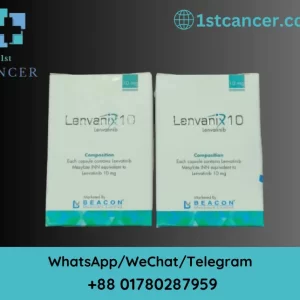Acalabrutinib (Everest Pharmaceuticals): A Breakthrough in Non-Hodgkin Lymphoma Treatment
Acalabrutinib is a cutting-edge anti‑cancer therapy sold under the brand name Everest Pharmaceuticals. This second‑generation Bruton’s tyrosine kinase (BTK) inhibitor is specifically designed to treat a range of non‑Hodgkin lymphomas, including mantle cell lymphoma (MCL) and chronic lymphocytic leukaemia (CLL)/small lymphocytic lymphoma (SLL). It is effective in both relapsed and treatment‑naive settings, offering new hope for patients facing these challenging cancers.
Key Features and Mechanism of Action
- Targeted BTK Inhibition: Acalabrutinib works by selectively blocking the BTK enzyme, a critical protein that supports the survival and growth of B cells. By inhibiting BTK, this medication slows the accumulation of malignant B cells in conditions like CLL, thereby delaying cancer progression.
- Next‑Generation Selectivity: As a second‑generation BTK inhibitor, acalabrutinib is engineered for higher selectivity compared to first‑generation inhibitors. This improved specificity contributes to a more favourable safety profile with fewer off‑target effects.
Medical Uses and Regulatory Approvals
In the European Union:
- Chronic Lymphocytic Leukaemia: Acalabrutinib is approved as a monotherapy or in combination with obinutuzumab for adults with previously untreated CLL.
- Relapsed CLL: It is also indicated for adults who have received at least one prior therapy.
In the United States:
- Mantle Cell Lymphoma: The medication is approved for adults with MCL who have undergone at least one line of prior therapy.
- Chronic Lymphocytic Leukaemia/Small Lymphocytic Lymphoma: Acalabrutinib is indicated for these conditions as well.
- Recent Approvals: In January 2025, the U.S. Food and Drug Administration (FDA) granted traditional approval for acalabrutinib in combination with bendamustine and rituximab. This regimen is specifically for adults with previously untreated MCL who are ineligible for autologous hematopoietic stem cell transplantation. Additionally, acalabrutinib received accelerated approval in 2017 for similar indications.
Common Side Effects
While acalabrutinib is an effective treatment option, patients may experience a range of side effects, including:
- Headaches and Fatigue: These are among the most frequently reported adverse events.
- Hematologic Effects: Patients may encounter low counts of red blood cells, platelets, and white blood cells.
- Other Observations: Diarrhoea and weight gain have also been noted, though data suggest acalabrutinib may offer a reduced risk of severe skin rash, intense diarrhoea, and bleeding compared to other BTK inhibitors such as ibrutinib.
Clinical History and Research Highlights
- Clinical Trials: The efficacy of acalabrutinib, particularly in combination with bendamustine and rituximab, was evaluated in the robust multicentre ECHO trial (NCT02972840), which involved 598 participants with untreated MCL aged 65 or older. This trial contributed significantly to its regulatory approvals by demonstrating clear clinical benefits.
- Research and Selectivity: Relative to ibrutinib, pre‑clinical studies have underscored the enhanced selectivity of acalabrutinib. It shows virtually no inhibition of other kinases—including ITK, EGFR, ERBB2, and others—minimising potential side effects like thrombus formation.
Legal Status and Market Impact
- Orphan Drug Designation: Acalabrutinib has received orphan drug status in both the U.S. and Europe for its indications in mantle cell lymphoma, CLL/SLL, and lymphoplasmacytic lymphoma (Waldenström’s macroglobulinaemia). This designation guarantees up to 10 years of market exclusivity within Europe.
- Economic Influence: Developed by Acerta Pharma, the promising results from early studies led to a major investment by AstraZeneca. In December 2015, AstraZeneca acquired a 55% stake in Acerta Pharma for $4 billion, with an option to acquire the remaining 45% based on future regulatory approvals and market success.
Conclusion
Acalabrutinib represents a significant advancement in targeted cancer therapy. By efficiently blocking BTK, it offers a potent treatment option for various forms of non‑Hodgkin lymphoma, particularly mantle cell lymphoma and CLL/SLL. Its favourable safety profile and robust clinical evidence set it apart as a key player in modern oncology.
For healthcare professionals and patients seeking state‑of‑the‑art treatment options in lymphoma, acalabrutinib provides a compelling balance of efficacy and safety, paving the way for improved patient outcomes in the battle against cancer.


